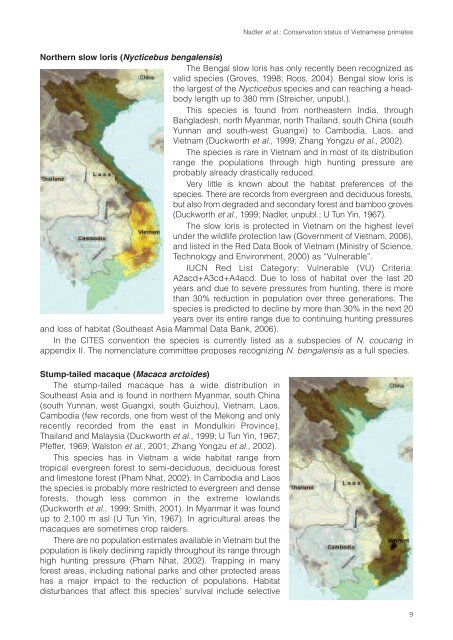Vietnamese Journal of Primatology - Frankfurt Zoological Society
Vietnamese Journal of Primatology - Frankfurt Zoological Society
Vietnamese Journal of Primatology - Frankfurt Zoological Society
You also want an ePaper? Increase the reach of your titles
YUMPU automatically turns print PDFs into web optimized ePapers that Google loves.
Nadler et al.: Conservation status <strong>of</strong> <strong>Vietnamese</strong> primates<br />
Northern slow loris (Nycticebus bengalensis)<br />
The Bengal slow loris has only recently been recognized as<br />
valid species (Groves, 1998; Roos, 2004). Bengal slow loris is<br />
the largest <strong>of</strong> the Nycticebus species and can reaching a headbody<br />
length up to 380 mm (Streicher, unpubl.).<br />
This species is found from northeastern India, through<br />
Bangladesh, north Myanmar, north Thailand, south China (south<br />
Yunnan and south-west Guangxi) to Cambodia, Laos, and<br />
Vietnam (Duckworth et al., 1999; Zhang Yongzu et al., 2002).<br />
The species is rare in Vietnam and in most <strong>of</strong> its distribution<br />
range the populations through high hunting pressure are<br />
probably already drastically reduced.<br />
Very little is known about the habitat preferences <strong>of</strong> the<br />
species. There are records from evergreen and deciduous forests,<br />
but also from degraded and secondary forest and bamboo groves<br />
(Duckworth et al., 1999; Nadler, unpubl.; U Tun Yin, 1967).<br />
The slow loris is protected in Vietnam on the highest level<br />
under the wildlife protection law (Government <strong>of</strong> Vietnam, 2006),<br />
and listed in the Red Data Book <strong>of</strong> Vietnam (Ministry <strong>of</strong> Science,<br />
Technology and Environment, 2000) as “Vulnerable”.<br />
IUCN Red List Category: Vulnerable (VU) Criteria:<br />
A2acd+A3cd+A4acd. Due to loss <strong>of</strong> habitat over the last 20<br />
years and due to severe pressures from hunting, there is more<br />
than 30% reduction in population over three generations. The<br />
species is predicted to decline by more than 30% in the next 20<br />
years over its entire range due to continuing hunting pressures<br />
and loss <strong>of</strong> habitat (Southeast Asia Mammal Data Bank, 2006).<br />
In the CITES convention the species is currently listed as a subspecies <strong>of</strong> N. coucang in<br />
appendix II. The nomenclature committee proposes recognizing N. bengalensis as a full species.<br />
Stump-tailed macaque (Macaca arctoides)<br />
The stump-tailed macaque has a wide distribution in<br />
Southeast Asia and is found in northern Myanmar, south China<br />
(south Yunnan, west Guangxi, south Guizhou), Vietnam, Laos,<br />
Cambodia (few records, one from west <strong>of</strong> the Mekong and only<br />
recently recorded from the east in Mondulkiri Province),<br />
Thailand and Malaysia (Duckworth et al., 1999; U Tun Yin, 1967;<br />
Pfeffer, 1969; Walston et al., 2001; Zhang Yongzu et al., 2002).<br />
This species has in Vietnam a wide habitat range from<br />
tropical evergreen forest to semi-deciduous, deciduous forest<br />
and limestone forest (Pham Nhat, 2002). In Cambodia and Laos<br />
the species is probably more restricted to evergreen and dense<br />
forests, though less common in the extreme lowlands<br />
(Duckworth et al., 1999; Smith, 2001). In Myanmar it was found<br />
up to 2,100 m asl (U Tun Yin, 1967). In agricultural areas the<br />
macaques are sometimes crop raiders.<br />
There are no population estimates available in Vietnam but the<br />
population is likely declining rapidly throughout its range through<br />
high hunting pressure (Pham Nhat, 2002). Trapping in many<br />
forest areas, including national parks and other protected areas<br />
has a major impact to the reduction <strong>of</strong> populations. Habitat<br />
disturbances that affect this species’ survival include selective<br />
9
















